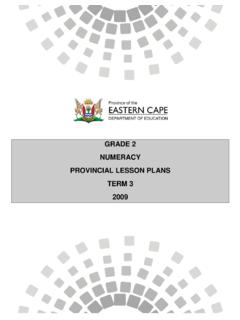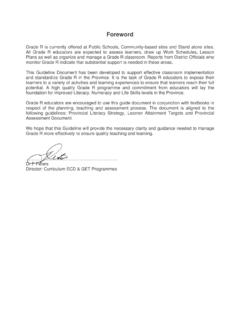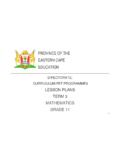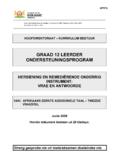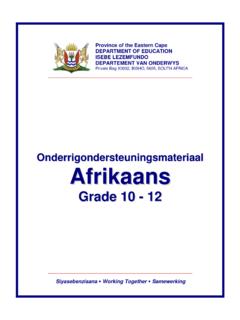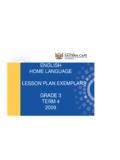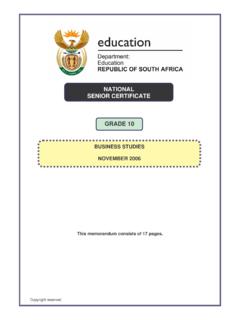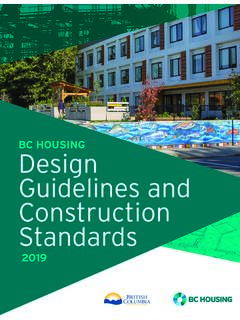Transcription of FOREWORD - Curriculum
1 1 2 FOREWORD The Handwriting Guide has been developed for foundation phase teachers to manage the teaching of Handwriting for Grades R to 3. The content of this document addresses the clarity sought by teachers and their concerns expressed during the contact sessions held with the provincial and District Officials. It addresses the following aspects: perceptual development (Writing readiness) the purpose of various stages of handwriting, letter formation, physical factors that impact on handwriting and the different writing styles The teaching of handwriting is incorporated into the Curriculum and Assessment Policy Statement (CAPS) for Languages, in terms of the policy prescripts to ensure that the basic writing skills are taught from Grade R to 3.
2 It is hoped that this support material will provide the necessary clarity and guidance that teachers need to manage the teaching of Handwriting successfully and confidently. _____ Dr T Reddy CES: ECD/Foundation Phase 3 TABLE OF CONTENTS PAGE 1 Handwriting 3 What is handwriting? 3 Why should you teach handwriting? 3 What is involved in handwriting? 3 Stages of handwriting 4 2. What must you observe? 14 Furniture 14 Posture 15 Lightning 15 Pencil Grip 15 Right handed learner 16 Left handed learner 17 Position of paper for the right handed child 18 Position of paper for the left handed child 18 3.
3 What learning and teaching materials do you need to teach handwriting? 19 4. When do you teach handwriting? 19 5. What writing style must we choose? 22 6. What good handwriting habits should be developed? 22 7. What must you teach? 22 Writing patterns 22 Letter shapes 24 Letter formation 26 Small letters 26 Capital letters 30 Capital letter families 31 Important factors 31 Cursive Writing 31 8 Other scripts 34 4 THE TEACHING OF HANDWRITING 1. Handwriting What is handwriting? Handwriting is a skill which learners cannot discover for themselves. Handwriting means the legible formation of letters, words and numerals.
4 The learners must be taught how to form the letters and then practice it. It is essential that learners master the skills of handwriting, because although handwriting may be supplemented by technical aids such as the computer, it can never be replaced completely. Although learners will develop their own writing style in later years , it is essential that they use the correct pencil grip and are taught to form the letters , the starting point ,size, shape, direction of movement and how letters are positioned on/spaced between the lines Learners need to develop a script that is legible and clear, while speed is developed gradually.
5 Handwriting should be seen as the learning and mastering of a handwriting system and the effective use of that mechanical system. At the end of the Foundation Phase all aspects such as correct letter and figure formation, size, spacing, clarity, legibility of print and script should be mastered. The basis of good handwriting is repetition. Why should you teach handwriting? Learners need to write clearly and easily with increasing speed as a result of frequent practice. Learners who cannot finish tasks in time are often mistaken as having a problem with content. Like all skills handwriting needs to be taught, it cannot be acquired automatically.
6 What is involved in handwriting? In writing the spoken word has to be converted into visual images. Visual motor co-ordination plays a decisive role in writing. The hand and eye must co-ordinate Before attempting any formal handwriting, certain development has to take place and the learner will go through different stages of development. This will enable the learner s ability to correctly see, copy and draw / write patterns and letters. 5 Stages of handwriting Pre - writing: Writing Readiness and Emergent Writing (THIS STAGE IS VERY IMPORTANT FOR GRADE R) Perceptual abilities This is the ability of the brain to give meaning to information send to it by means of the five senses.
7 The eye for example sees an object (letter), but the brain tells what it is. Visual Perception is important in writing, drawing, copying, tracing, cutting, pasting etc. During visual perception the brain interprets stimuli through the eyes. Visual Discrimination This is the ability to see differences and similarities and to recognise the difference between for example a b and a d , p and b and 6 and 9 EXAMPLES Circle the picture that is exactly the same as the picture in the box Match pictures that are the same 6 Visual Memory It is the ability to remember what the eyes have seen.
8 This is when the child cannot remember how to copy the letter or drawing he has seen on the board. Young learners often find difficulty in copying from the chalkboard as their eyes need time to refocus from the board to the page in front of them and their short term visual memory is not well developed. EXAMPLES Show 4 objects and remove one OR Draw a shape or form on a board then close the board and learners must copy the shape OR Put objects fruit on a table, close with a cloth and learners must name the fruit.
9 Visual Sequencing Sequencing means arranging pictures or symbols in such a way that they form a story or pattern. In Grade R the learner will be expected to be able to select, classify, and correctly place pictures in a sequence. In Grades 1,2 and 3 he will place letters in order in a word. EXAMPLES : copy pegs, copy blocks, order of objects, re-draw a pattern Circle the one that looks different b b d b b 7 Putting pictures in a sequence Visual motor co-ordination This enables the child to carry out movements with the body or parts of the body all movements with the body or with parts of the body is guided by vision e.
10 G: - swinging balls - swing ball (bat & ball) - ball games - flip and catch beanbags - move cars - marble runs Gross motor movements will develop, strengthen and stabilize shoulders and arms which allow the hands to move more effectively play catch with both hands - using balls of different sizes, swinging on playground equipment etc. 8 Fine motor Skills The school beginner must have sufficient control and co-ordination of the small muscles of the body to be able to manipulate small objects and to handle writing materials. In the classroom the learner is expected to perform a number of accurate tasks with his fingers and hands.
